Hip survival after periacetabular osteotomy in patients with acetabular dysplasia, acetabular retroversion, congenital dislocation of the hip, or Legg-Calvé-Perthes disease: a cohort study on 1,501 hips
- PMID: 37170805
- PMCID: PMC10176202
- DOI: 10.2340/17453674.2023.12403
Hip survival after periacetabular osteotomy in patients with acetabular dysplasia, acetabular retroversion, congenital dislocation of the hip, or Legg-Calvé-Perthes disease: a cohort study on 1,501 hips
Abstract
Background and purpose: Previous studies on hip survival following periacetabular osteotomy (PAO) have reported isolated data for the treatment of 1 underlying condition, making comparison between patient groups difficult. We report the hip survival after PAO in patients with acetabular dysplasia (AD), acetabular retroversion (AR), congenital dislocation of the hip (CDH), and Legg-Calvé-Perthes disease (LCPD) with total hip arthroplasty (THA) as primary endpoint and secondarily the risk of subsequent hip-related operations other than THA.
Patients and methods: From 1997 to December 2021, 1,501 hips (1,203 patients) underwent PAO in a single center (Odense University Hospital). We identified conversions to THA and other subsequent hip-related operations through patient files and the Danish National Patient Registry (DNPR).
Results: 123 (8.2%) of the total cohort of 1,501 hips were converted to THA within the study period. The overall Kaplan-Meier hip survival rate was 71% (95% confidence interval [CI] 61-79) at 24 years with a mean follow-up of 7.6 years (range 0.02-25). The individual Kaplan-Meier hip survival rates at 15 years were 81% (CI 76-86) for AD, 94% (CI 91-96) for AR, 84% (CI 66-93) for CDH, and 66% (CI 49-79) for LCPD. In total, the overall risk of additional hip-related operations was 48% (of which 92% were screw removal).
Conclusion: Encouragingly, 71% of hips were preserved 24 years after PAO. We found that AR patients had the highest (94%) PAO survivorship at 15 years compared with the other underlying hip conditions. Almost half of PAO patients may undergo later additional surgery, of which screw removal is the primary intervention. Overall long-term survival, risk factors for conversion to THA, and risk of additional surgery are relevant information for shared decision-making.
Figures



References
-
- Ganz R, Klaue K, Vinh T S, Mast J W. A new periacetabular osteotomy for the treatment of hip dysplasias: technique and preliminary results. Clin Orthop Relat Res 1988; (232): 26-36. PMID: . - PubMed
-
- Harris W H. Etiology of osteoarthritis of the hip. Clin Orthop Relat Res 1986; (213): 20-33. PMID: . - PubMed
MeSH terms
LinkOut - more resources
Full Text Sources
Medical
Research Materials

